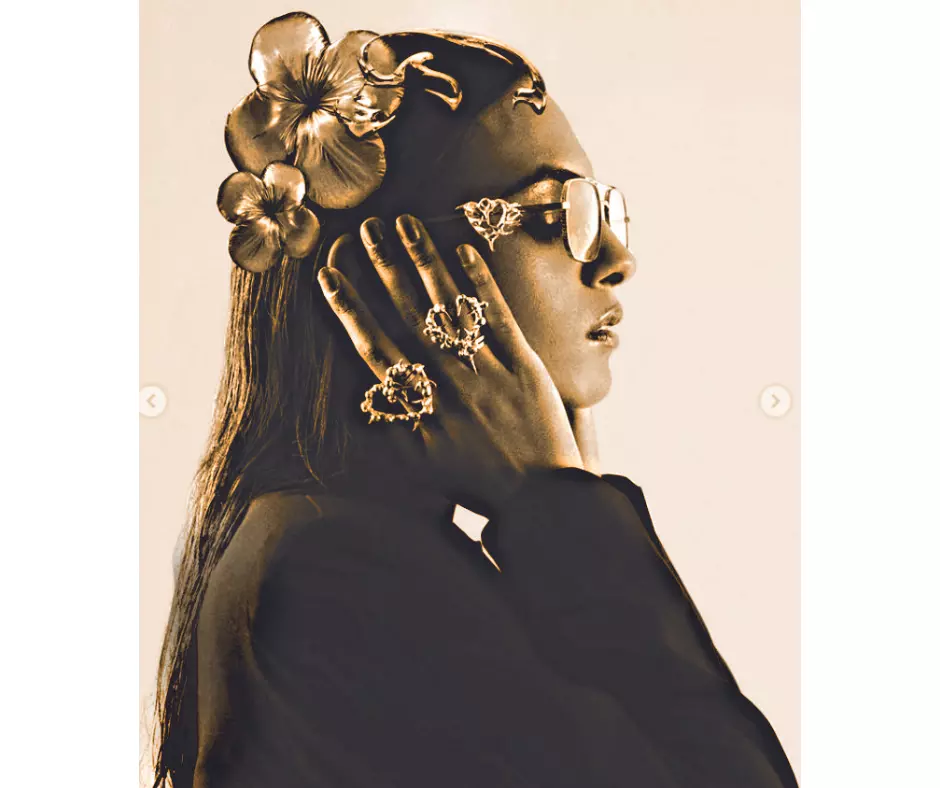FOLKLORES IN FABRICS
Millennials and Gen-Z are smitten by quirky designs of mythology and folktales on the fashion canvas

Ugly Cupid’s cyber sigilism accessories. (Image: Instagram)
Indian fashion has always been a confluence of cultures and influences from playful reinterpretations of iconic mythological characters to subtle motifs woven into designs. The young generation is highly enthusiastic about fashion and willing to experiment with traditional designs that have the eccentricity of a modern touch. This trend extends beyond the realm of high fashion and ramp walks.
India’s rich traditional art forms boast a treasure trove of myths and folktales. Art forms like Kalamkari use hand-painted scenes from epics, while block printing allows intricate mythological motifs to be imprinted onto fabrics. Embracing such traditional art forms, Chitrakathii, founded by Manisha Dokania, is weaving the style of traditional art forms into motifs inspired by mythology and folktales. Manisha, says, “I want to use the elements from Indian art, and put it in a way that has a wider appeal. Chitrakathii is about keeping the Indian art alive, not taking the essence away, but adapting it to today’s taste. All the motifs are hand embroidered.” The meaning of Chitrakathii is ‘stories through pictures.’ One of the motifs and their brand logo, the Padma Phool, is a pink lotus flower. The design of this motif is inspired by Orissa’s Pattachitra. It is our national flower and in mythology, it’s the flower on which Goddess Lakshmi sits. Also, the metaphorical meaning of lotus symbolises life, rebirth and regeneration.
Shaishavi Mehta, founder-creative director of RAFU’D, says, “With each collection, I try to explore a different narrative textile which was essentially used as a medium of storytelling throughout generations. These textiles carried graphic tales from local deities.” Her first collection was inspired by Phad Paintings. This art form was a 20-meter scroll that told the stories of their local deity Pabuji and Devnarayan. She took inspiration from their colours, graphics and the tale they portray.
Eccentricity+Tradition
Designers are reinterpreting iconic characters from holy books, mythologies, and folklore through their contemporary lens. Playful prints feature deities or iconic mythological characters on t-shirts, shorts, hoodies and jackets. Shaishavi brings eccentricity to her designs by finding a personal connection to the art forms. She explains, “Our second collection is inspired by Mata Ni Pachedi, an art form based in Ahmedabad which is put behind the idols of the mother goddess.
Eccentricity+Tradition
Designers are reinterpreting iconic characters from holy books, mythologies, and folklore through their contemporary lens. Playful prints feature deities or iconic mythological characters on t-shirts, shorts, hoodies and jackets. Shaishavi brings eccentricity to her designs by finding a personal connection to the art forms. She explains, “Our second collection is inspired by Mata Ni Pachedi, an art form based in Ahmedabad which is put behind the idols of the mother goddess.
A lot of these are also worshipped during Navratri. The idea was to make the prints seem like vibrant dancing figures set on a night sky just
like an image of a Navratri ground.” However, Manisha believes, “While the inspiration might be mythological, the initial appeal mostly lies in the design itself. People are attracted to quirky and unique designs. We educate customers about the story behind every design, but there's room for more awareness about these rich Indian art forms.”
like an image of a Navratri ground.” However, Manisha believes, “While the inspiration might be mythological, the initial appeal mostly lies in the design itself. People are attracted to quirky and unique designs. We educate customers about the story behind every design, but there's room for more awareness about these rich Indian art forms.”
Streetwear Fashion
Streetwear is getting a mythical makeover. Young consumers embrace bold fashion choices and are open to experimenting. Also, this generation is inclined towards brands that promote Indian culture and embrace it through fusion. Whether it is Almost God’s print of the Leviathan, a sea serpent in mythology on a T-shirt, an all-over print depicting the battle of two of the strongest animals in Chinese mythology, or Ugly Cupid's pieces embodying the spirit of cyber sigilism in accessories evoking a gothic edge.
Streetwear is getting a mythical makeover. Young consumers embrace bold fashion choices and are open to experimenting. Also, this generation is inclined towards brands that promote Indian culture and embrace it through fusion. Whether it is Almost God’s print of the Leviathan, a sea serpent in mythology on a T-shirt, an all-over print depicting the battle of two of the strongest animals in Chinese mythology, or Ugly Cupid's pieces embodying the spirit of cyber sigilism in accessories evoking a gothic edge.
Millennials and Gen-Z are drawn to narratives. Mythology and folklore provide a wealth of stories that designers can translate visually, creating a unique and engaging experience for the wearer. The use of mythology allows designers to create a unique fusion of tradition and modernity. Gen-Z is using fashion more and more as an extension of their personality. Shaishavi says, “Clothes have always been the second skin to mankind, and finding niche brands that cater to a very specific aesthetic feels like finding a long-lost friend that understands a part of you. People are finding unique ways to connect with what makes them as they are and homegrown brands are playing a vital role in it.”
"While the inspiration might be mythological, the initial appeal mostly lies in the design itself.” — Manisha Dokania, founder, Chitrakathii
"With each collection, I try to explore a different narrative textile which was essentially used as a medium of storytelling throughout generations.”— Shaishavi Mehta,
founder and creative director, RAFU’D
founder and creative director, RAFU’D
( Source : Deccan Chronicle )
Next Story

